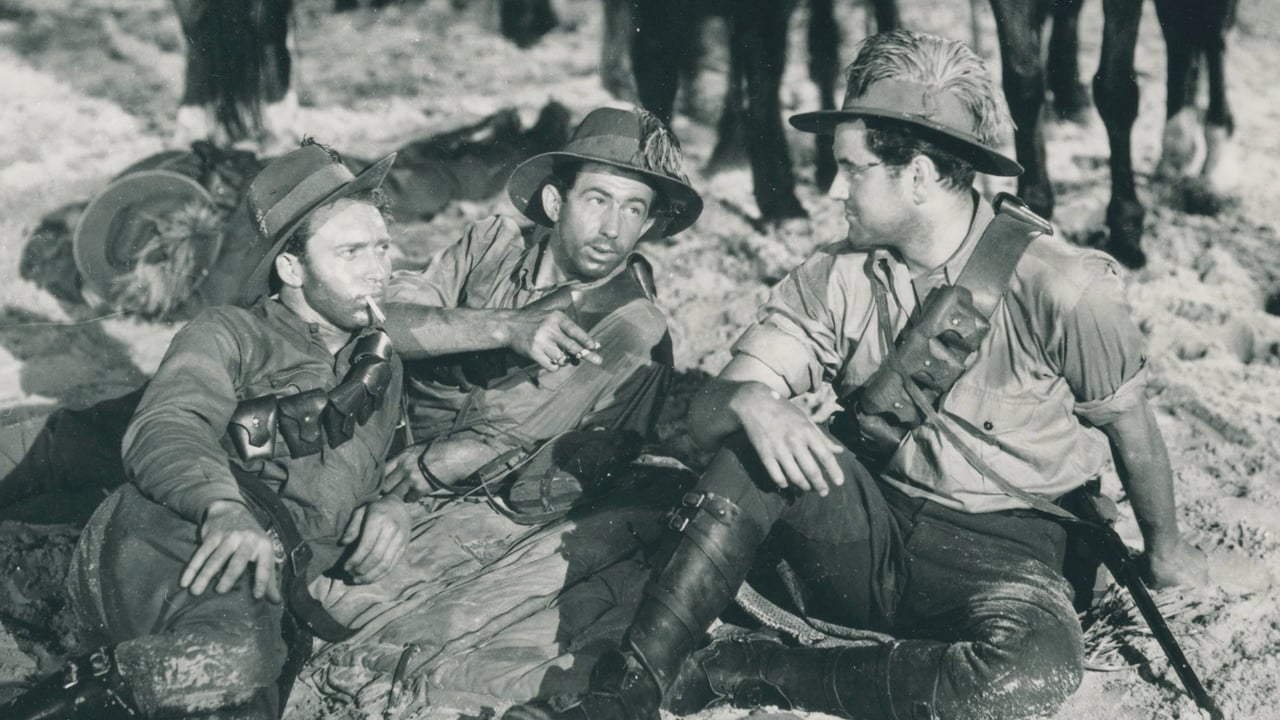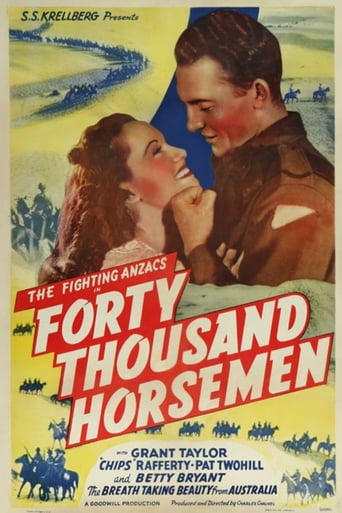

40,000 Horseman tells the story of the Australian Light Horse cavalry which operated in the desert in Palestine and probably has to its credit the last successful cavalry charge in battle, though apparently according to other reviewers some who dispute it. I'm perfectly willing to give credit to Australia for this remarkable achievement.The story was filmed in 1940 when Australia had already entered World War II and troops were in the Sahara Desert while this movie was made. For propaganda necessity a hateful German had to be made the villain and Harvey Adams as Van Hausen certainly fills the bill there. To be sure Germans were in the desert, but the bulk of the fighting troops were the Aussies old foes from Gallipoli, the Turks. After all Palestine was part of their Ottoman Empire.The film was made by Charles Clauvel who's uncle Sir Harry Clauvel was the actual general in charge of the Australian Light Horse. Perhaps the younger Clauvel was undergoing an attack of modesty, but personally I'd have rather seen the story of the uncle and the battles done in a documentary style like The Longest Day.However several Australian acquaintances have told me that this film is regularly shown on Australian television on ANZAC day. Though the courage of the Aussies at Gallipoli gave the new continent nation a sense of national identity, this film does show them winning this one.It's the final cavalry charge at Beersheba which opened the way for General Allenby to take Jerusalem is the main feature of the film. Even given the superior production facilities in America at the time, no Hollywood film could have staged the battle better. It is one of the most exciting charges I've ever seen done from any country.I'm still not sure what the contrived romance between half French half Arab girl Betty Bryant and Aussie cavalryman Grant Taylor was doing here. Most of the time Betty is disguised as a boy. I'm thinking that Charles Clauvel might have seen Katharine Hepburn in Sylvia Scarlett and thought it was cute.As one of Taylor's mates is Chips Rafferty who was THE Australian cinema star for three decades. This was the film that got him his first real notice.Though the film probably could use a modern remake in the manner of Breaker Morant and Gallipoli without the wartime propaganda and unnecessary love story tossed in, 40,000 Horseman is an exciting piece of cinema detailing the story of one of the great events in Australian history. Maybe we'll get to see it on American television soon.
... View MoreBegins with a Two-up game when three Australian soldiers win three donkeys and all the clothes from some Arabs, dress the donkeys in the baggy pants and fez and ride into some bar as typical larrikins. Some stereotyped Germans speak flawed English to each other and are depicted as ruthlessly cruel. The love interest disguises herself as a boy with a high pitched voice, soft skin and breasts and fools everyone. She saves an injured soldier whose wound in the top right of his chest miraculously disappears apparently because of the wet cloth she placed on it. Three of the four leads die heroically and the best looking one gets to spend the night with the girl before winning the war and riding off into the sunset with her. Back in 1941 this no doubt would have made men cheer and women swoon, so it is best looked at as an artifact of an age of innocence. The effort expended in filming all those horses would have been huge. The Gaza and Beersheba reconstructions are fair. The acting is stagey. You just have to tolerate the jingoism and stereotypes. The Allies were fighting the Germans again when the film was released, so the propaganda motive is completely understandable.
... View MoreI definately liked this film mainly because it tells an important battle won by our brave Australian soldiers. Although the charge was made by the Light Horse which was mounted infantry it was the last REAL cavalry charge. The characters were very likeable Jim Bourke (Chips Rafferty) Red Gallagher (Grant Taylor) Larry Bourke (Pat Twohill) are all mates that are in the light horse, they are all Aussie bush men who joined up like so many others because it was the right thing to do. Its nice to see Chips Rafferty as the easy going Aussie bush man that made him famous. This movie was the predecessor to "The Rats Of Tobruk". In many ways they are both quite similar, they both talk about battles that are well known to Australians because they were both won by Australians, and they even use two of the same actors, Chips Rafferty and Grant Taylor. This movie and Rats Of Tobruk make great companions after spending ages looking for them i found copies of both them in the same shop. Both movies are very hard to find and if your a nationalist (like me) it will make you appreciate films like this a lot more so if you see a copy of this movie buy it.
... View MoreAlthough filmed 60 years ago I cannot think of a more thrilling realisation on film of a massed cavalry assault. The scene, which is sustained for several minutes, recreats the WWI charge of the Australian light horse on the Turkish-held town of Beersheeba, Palestine, in 1917. This is generally accepted as the last successful cavalry charge in military history (typically some eggheads - probably Brits - quibble on whether it was a true cavalry charge because the Australians were armed with bayonets rather than sabres; not that the distinction meant much to the unfortunates who ended up skewered on the end of them.)Also noteworthy for the presence of Chips Rafferty, in a typical role as a gangling Aussie bushmen, and who, in the days before Paul Hogan, represented the Australian male as he liked to imagine himself.
... View More